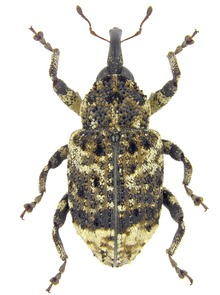Cryptorhynchinae
| Cryptorhynchinae | |
|---|---|

| |
| Cryptorhynchus lapathi | |
| Scientific classification | |
| Domain: | Eukaryota |
| Kingdom: | Animalia |
| Phylum: | Arthropoda |
| Class: | Insecta |
| Order: | Coleoptera |
| Infraorder: | Cucujiformia |
| Family: | Curculionidae |
| Subfamily: | Cryptorhynchinae Schönherr, 1825 |

Cryptorhynchinae is a large subfamily of weevils (
They are distinguished by having their
Some species of Cryptorhynchinae are considered agricultural pests, such as the mango seed weevil Sternochetus mangiferae, but the great majority of species live in primary forests, often on deadwood and are threatened by habitat loss. In Europe, the flightless genus Acalles is most diverse, and restricted to woodlands of long-lasting habitat continuity[4]
According to a biogeographical analysis[5] Cryptorhynchinae s.s. originated in the Late Cretaceous in South America. Within the ‘Acalles group’ and the ‘Cryptorhynchus group’, several independent dispersal events to the Western Palaearctic via the Nearctic occurred in the Late Cretaceous and Early Paleogene. A southern route via Antarctica allowed the colonization of Australia in the Late Cretaceous, where a diverse Indo-Australian clade probably emerged about 73 million years ago.
Genera
The following genera (among others) belong to the subfamily Cryptorhynchinae:
- Acalles Schönherr, 1825 i c g b
- Acallocrates Reitter, 1913 i c g b
- Achopera Pascoe, 1870 a
- Anaballus Blanchard, 1849 c g
- Apteromechus Faust, 1896 i c g b
- Asytesta Pascoe, 1865 c g
- Blepiarda Pascoe, 1865 c g
- Calles Kissinger, 1964 i c g b
- Canistes Casey, 1892 i c g b
- Cedilaus Lea, 1912 c g
- Cnemidoprion Marshall, 1933 c g b
- Cophes Champion, 1905 i c g b
- Cryptorhynchus Illiger, 1807 i c g b
- Didymus Kuschel, 1982 c g
- Episcirrus Kuschel, 1958 i c g b
- Eubulus Kirsch, 1870 i c g b
- Eurhoptus LeConte, 1876 i c g b
- Euscepes Schönherr, 1844 i c g b
- Eutinobothris b
- Faustinus Berg, 1898 i c g b
- Gasterocercus de Laporte Castelnau La Ferté-Sénectère & Brullé, 1828 c g
- Gerstaeckeria Champion, 1905 i c g b (cactus weevils)
- Hohonus Kissinger, 1964 i c g b
- Lembodes Schönherr, 1844 i c g b
- Liometophilus Fall, 1912 i c g b
- Maemactes Schönherr, 1837 i c g b
- Neoulosomus O'Brien & Wibmer, 1982 i c g b
- Paracamptus Casey, 1895 c g b
- Peracalles Kissinger, 1964 i c g b
- Poropterus Schönherr, 1844 c g
- Psepholax A.White, 1843 g
- Pseudoacalles Blatchley, 1916 i c g b
- Pseudomopsis Champion, 1905 i c g b
- Pseudomus Schönherr, 1837 i c g b
- Rhyephenes Schönherr, 1837
- Rhynchodes White, 1846 c g
- Rhynchus Kissinger, 1964 i c g b
- Sternochetus Pierce, 1917 i c g b
- Sudus Kissinger, 1964 i c g b
- Tepperia Kirby, 1910 g
- Tragopus Schoenherr, 1837 a c g
- Trigonopterus Fauvel, 1862 c g
- Troezon Champion, 1906 c g b
- Tyloderma Say, 1831 i c g b
- Zascelis LeConte, 1876 i c g b
- ZygaraPascoe, 1885 c g
Data sources: a=AFD,[6] i = ITIS,[7] c = Catalogue of Life,[8] g = GBIF,[9] b = Bugguide.net[10]
References
- ^ Lyal, C.H.C. (1993) Coleoptera: Cryptorhynchinae. Fauna of New Zealand 29. Lincoln, Canterbury. 1–308.
- ^ Lyal, C.H.C. (2014) 3.7.7 Molytinae Schoenherr, 1823. In: Leschen R.A.B. & Beutel, R.G. (Eds) Handbook of Zoology, Coleoptera, Beetles Volume 3: Morphology and Systematics (Phytophaga). DeGruyter, Berlin, 529–570.
- ^ Riedel, A., Tänzler, R., Pons, J., Suhardjono, Y. R., & Balke, M. (2016). Large-scale molecular phylogeny of Cryptorhynchinae (Coleoptera, Curculionidae ) from multiple genes suggests American origin and later Australian radiation. Systematic Entomology. http://doi.org/10.1111/syen.12170
- ^ Buse, J., (2012) “Ghosts of the past”: flightless saproxylic weevils (Coleoptera: Curculionidae) are relict species in ancient woodlands. Journal of Insect Conservation 16 (1), 93–102.
- ^ Letsch H., Balke M., Toussaint E.F.A. & Riedel A. (early online) Historical biogeography of the hyperdiverse hidden snout weevils (Coleoptera, Curculionidae, Cryptorhynchinae). Systematic Entomology. http://doi.org/10.1111/syen.12396
- ^ "Australian Faunal Directory: Cryptorhynchini names list for Australia". biodiversity.org.au. Retrieved 2022-03-30.
- ^ "ITIS, Integrated Taxonomic Information System". Retrieved 2018-04-25.
- ^ "Catalogue of Life". Retrieved 2018-04-25.
- ^ "GBIF". Retrieved 2018-04-25.
- ^ "Cryptorhynchinae Subfamily Information". BugGuide.net. Retrieved 2018-04-25.
![]() Data related to Cryptorhynchinae at Wikispecies
Data related to Cryptorhynchinae at Wikispecies
- ISBN 978-3-00-058038-3.
